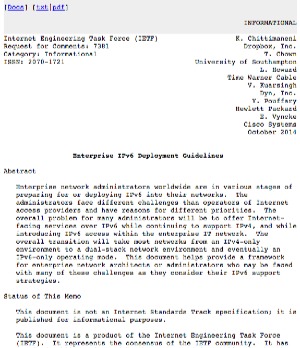 Would you like guidelines for how IPv6 can best be deployed in an enterprise environment? Yesterday the IETF published a new informational RFC 7381, “Enterprise IPv6 Deployment Guidelines” available at:
Would you like guidelines for how IPv6 can best be deployed in an enterprise environment? Yesterday the IETF published a new informational RFC 7381, “Enterprise IPv6 Deployment Guidelines” available at:
https://tools.ietf.org/html/rfc7381
The abstract for the document reads:
Enterprise network administrators worldwide are in various stages of preparing for or deploying IPv6 into their networks. The administrators face different challenges than operators of Internet access providers and have reasons for different priorities. The overall problem for many administrators will be to offer Internet-facing services over IPv6 while continuing to support IPv4, and while introducing IPv6 access within the enterprise IT network. The overall transition will take most networks from an IPv4-only environment to a dual-stack network environment and eventually an IPv6-only operating mode. This document helps provide a framework for enterprise network architects or administrators who may be faced with many of these challenges as they consider their IPv6 support strategies.
The document then goes on to outline several phases of IPv6 deployment within an enterprise. The Table of Contents gives a good sense of what is in the document:
1. Introduction . . . . . . . . . . . . . . . . . . . . . . . . 4
1.1. Enterprise Assumptions . . . . . . . . . . . . . . . . . 5
1.2. IPv4-Only Considerations . . . . . . . . . . . . . . . . 5
1.3. Reasons for a Phased Approach . . . . . . . . . . . . . . 6
2. Preparation and Assessment Phase . . . . . . . . . . . . . . 7
2.1. Program Planning . . . . . . . . . . . . . . . . . . . . 7
2.2. Inventory Phase . . . . . . . . . . . . . . . . . . . . . 8
2.2.1. Network Infrastructure Readiness Assessment . . . . . 8
2.2.2. Application Readiness Assessment . . . . . . . . . . 9
2.2.3. Importance of Readiness Validation and Testing . . . 9
2.3. Training . . . . . . . . . . . . . . . . . . . . . . . . 10
2.4. Security Policy . . . . . . . . . . . . . . . . . . . . . 10
2.4.1. IPv6 Is No More Secure Than IPv4 . . . . . . . . . . 10
2.4.2. Similarities between IPv6 and IPv4 Security . . . . . 11
2.4.3. Specific Security Issues for IPv6 . . . . . . . . . . 11
2.5. Routing . . . . . . . . . . . . . . . . . . . . . . . . . 13
2.6. Address Plan . . . . . . . . . . . . . . . . . . . . . . 14
2.7. Tools Assessment . . . . . . . . . . . . . . . . . . . . 16
3. External Phase . . . . . . . . . . . . . . . . . . . . . . . 17
3.1. Connectivity . . . . . . . . . . . . . . . . . . . . . . 18
3.2. Security . . . . . . . . . . . . . . . . . . . . . . . . 19
3.3. Monitoring . . . . . . . . . . . . . . . . . . . . . . . 20
3.4. Servers and Applications . . . . . . . . . . . . . . . . 20
3.5. Network Prefix Translation for IPv6 . . . . . . . . . . . 21
4. Internal Phase . . . . . . . . . . . . . . . . . . . . . . . 21
4.1. Security . . . . . . . . . . . . . . . . . . . . . . . . 22
4.2. Network Infrastructure . . . . . . . . . . . . . . . . . 22
4.3. End-User Devices . . . . . . . . . . . . . . . . . . . . 23
4.4. Corporate Systems . . . . . . . . . . . . . . . . . . . . 24
5. IPv6 Only . . . . . . . . . . . . . . . . . . . . . . . . . . 24
6. Considerations for Specific Enterprises . . . . . . . . . . . 26
6.1. Content Delivery Networks . . . . . . . . . . . . . . . . 26
6.2. Data Center Virtualization . . . . . . . . . . . . . . . 26
6.3. University Campus Networks . . . . . . . . . . . . . . . 26
7. Security Considerations . . . . . . . . . . . . . . . . . . . 28
8. Informative References . . . . . . . . . . . . . . . . . . . 28
The document is a good one for all people involved with enterprises to read and we’ll be adding the document to our “IPv6 for Enterprises” page soon. We’d encourage you to read this RFC 7381 and share it with others. Please do also check out other resources that are available for enterprises looking to make the move to IPv6.
